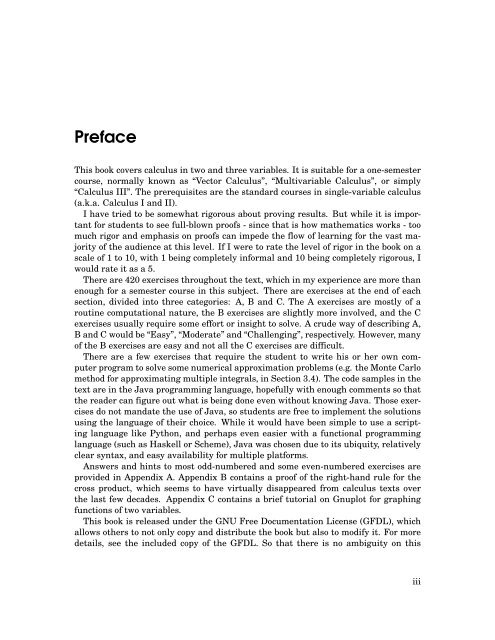Michael Corral: Vector Calculus
Michael Corral: Vector Calculus
Michael Corral: Vector Calculus
Create successful ePaper yourself
Turn your PDF publications into a flip-book with our unique Google optimized e-Paper software.
Preface<br />
This book covers calculus in two and three variables. It is suitable for a one-semester<br />
course, normally known as “<strong>Vector</strong> <strong>Calculus</strong>”, “Multivariable <strong>Calculus</strong>”, or simply<br />
“<strong>Calculus</strong> III”. The prerequisites are the standard courses in single-variable calculus<br />
(a.k.a. <strong>Calculus</strong> I and II).<br />
I have tried to be somewhat rigorous about proving results. But while it is important<br />
for students to see full-blown proofs - since that is how mathematics works - too<br />
much rigor and emphasis on proofs can impede the flow of learning for the vast majority<br />
of the audience at this level. If I were to rate the level of rigor in the book on a<br />
scale of 1 to 10, with 1 being completely informal and 10 being completely rigorous, I<br />
would rate it as a 5.<br />
There are 420 exercises throughout the text, which in my experience are more than<br />
enough for a semester course in this subject. There are exercises at the end of each<br />
section, divided into three categories: A, B and C. The A exercises are mostly of a<br />
routine computational nature, the B exercises are slightly more involved, and the C<br />
exercises usually require some effort or insight to solve. A crude way of describing A,<br />
BandCwouldbe“Easy”,“Moderate”and“Challenging”,respectively. However,many<br />
of the B exercises are easy and not all the C exercises are difficult.<br />
There are a few exercises that require the student to write his or her own computerprogramtosolvesomenumericalapproximationproblems(e.g.<br />
theMonteCarlo<br />
method for approximating multiple integrals, in Section 3.4). The code samples in the<br />
text are in the Java programming language, hopefully with enough comments so that<br />
the reader can figure out what is being done even without knowing Java. Those exercises<br />
do not mandate the use of Java, so students are free to implement the solutions<br />
using the language of their choice. While it would have been simple to use a scripting<br />
language like Python, and perhaps even easier with a functional programming<br />
language (such as Haskell or Scheme), Java was chosen due to its ubiquity, relatively<br />
clear syntax, and easy availability for multiple platforms.<br />
Answers and hints to most odd-numbered and some even-numbered exercises are<br />
provided in Appendix A. Appendix B contains a proof of the right-hand rule for the<br />
cross product, which seems to have virtually disappeared from calculus texts over<br />
the last few decades. Appendix C contains a brief tutorial on Gnuplot for graphing<br />
functions of two variables.<br />
This book is released under the GNU Free Documentation License (GFDL), which<br />
allows others to not only copy and distribute the book but also to modify it. For more<br />
details, see the included copy of the GFDL. So that there is no ambiguity on this<br />
iii








